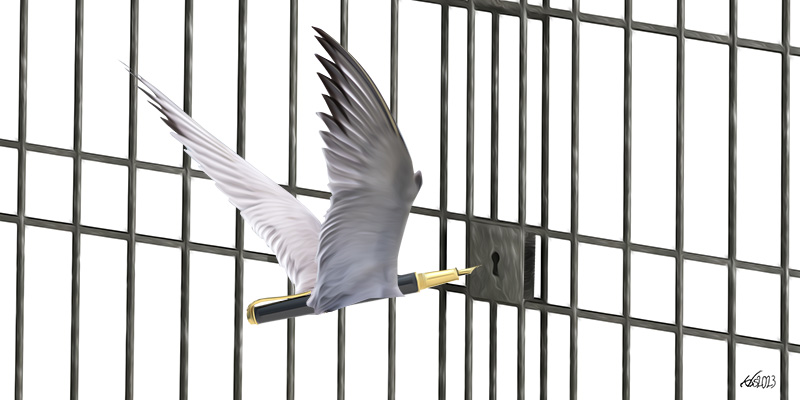A sudden, frenzied and unusual search in my cell. I didn’t know exactly what they were looking for. But they found leaves of toilet paper I had written a poem on. They confiscated all the 14 verses of my poem Kamliwaze (Go and Comfort Him). It is a pity I’ve lost it, especially that I had memorized only the first four stanzas of it. The rest is now gone and lost. Fortunately, they couldn’t find the other three poems (Nshishiyelo ni Lilo, Tuza Moyo and Jipu), which I had wrapped in a plastic paper and tossed them in my urine pot for ‘safe custody’; and also the two poems (“Siwati” and “Mamba”), which were dangling on a blanket thread outside my cell window. But I doubt if they will be able to make out the meaning of the poems. Even if they will, I have 1001 alternative interpretations for each one of them. May 22, 1970
This is how Professor Abdilatif Abdalla, arguably the first political prisoner and author in post-independence Kenya, captured the early morning raid in his cell in a dairy of his time at the Kamiti Maximum Security Prison. He was lucky that even the diary that was later published in the Africa Events magazine survived the raid and in its own way contributed to the prison literature sub-genre. Prison literature—novels, short stories, poems or plays that delve into the horrid conditions and experiences in prison—has increased immensely, a global phenomenon whose importance in examining the struggles in the society cannot be ignored.
A study of African literature that does not delve into the writings and the writers who have been so prolific while in prison would be incomplete. The sub-genre includes works that give insight into the independence struggle, such as the autobiography of Ghana’s first president, the late Kwame Nkrumah, which he wrote in James Fort Prison where had been incarcerated by the British colonialists for agitating for his country’s independence.
The post-independence era in Africa is a remarkable one; the continent experienced turbulent times, with liberators-turned-oppressors using the same methods as the colonialists to suppress dissent. The sub-genre is thus closely linked to the democratization of our society and these are writings that provide an accurate and comprehensive commentary on the socio-economic and political development of Kenya and of Africa in general. They are an important resource, showing us where we are coming from and shining a light on the fragments scattered along the political, economic and social path that we have trod as a country and as a continent.
Prison writings are a complex body of work that can be classified variously. The two major classifications are the traditional ones, namely, fiction and non-fiction. Non-fiction is further sub-divided into that which is mainly historical and that which is merely a diary of events.
However, whether fiction or non-fiction, these writings vividly capture the gruesome experiences lived in the state’s corridors of silence. In some countries, the writings can be traced as far back as the colonial days and serve as beacons in the post-independence history of a country, where it has come from and where it has reached in its quest for justice, upholding the rule of law and ensuring that fundamental human rights are respected; they are a vast body of knowledge that tells the African tale.
Kenya’s prison writings begin during the British colonial rule that saw many of those calling for self-determination thrown into jail and into detention camps. Graduates of these jails and detention camps captured their experiences on paper, tracing a path that has been followed by subsequent writers. The late JM Kariuki was among the first Kenyans to capture his experiences in detention in his non-fiction account Mau Mau in Detention published in 1963, opening the floodgates of tales of the independence struggle, the telling of which had hitherto been skewed in favour of the oppressors.
An established writer and publisher, Gakaara wa Wanjau had the misfortune of being imprisoned in both colonial and independent Kenya. He documented his experience in the British corridors of silence in his book Mwandiki wa Mau Mau Ithamerio-ine (Mau Mau Author in Detention).
Over the decades, independent Kenya has produced more and better works that examine themes such as the gradually growing intolerance to dissenting views and even the suppression of dissenters. The doors to this literature were opened by Abdulatif Abdullah, the first post-independence Kenyan political prisoner.
Abdulatif was imprisoned by the Kenyatta regime for four years and subjected to hard labour after writing an article titled Kenya: Twendapi? (Kenya: Where Are We Headed?) in reaction to the disbandment of KPU. While serving his term, Abdilatif wrote a collection of poems titled Sauti ya Dhiki, which ironically won him the second edition of the prestigious Jomo Kenyatta Prize for Literature.
The doors to this literature were opened by Abdulatif Abdullah, the first post-independence Kenyan political prisoner.
Other writers were to follow and each chose a unique way to capture the horrific jail conditions. The most famous of these writers is Ngugi wa Thiong’o. His activities at the Kamirithu community theatre led to his detention in 1977 and he wrote Detained: A Writer’s Prison Diary—taking a departure from fiction—while incarcerated at Kamiti. Others who have contributed greatly to this body of work include Maina wa Kinyatti, Koigi wa Wamwere and, more recently, Wanyiri Kihoro.
Maina wa Kinyatti has perhaps the highest number of books that vividly describe his harrowing experience in prison. He has published a collection of poems titled A Season of Blood: Poems from Kenyan Prisons (1995), a book of his recollections titled Kenya: A Prison Notebook (1996) and Mother Africa, which chronicles his arrest, torture and imprisonment.
Former Nyeri Town Member of Parliament Wanyiri Kihoro has documented his ordeal in Never Say Die, described by the late Wahome Mutahi as a brilliant piece of work that accurately details the events that took place at the infamous Nyayo House basement cells.
The late Wahome Mutahi also captured his own ghastly experiences in two insightful accounts—Three Days on the Cross and Jail Bugs. Wahome was arrested a few days after he submitted the manuscript for Three Days on the Cross to publishers. Upon his release, the publishers asked him to revise the manuscript to incorporate the details of his latest incarceration.
There are many other works that have been written that are largely fictional, several of which are thrilling, fast-paced dramas. East African Educational Publishers has a large collection of the genre, listed under their Spear series. Many of these writings are largely confessions of erstwhile crooks—such as John Kiriamiti’s My Life in Crime, Kiggia Kimani’s Prison is Not a Holiday Camp or Charles Githae’s Comrade Inmate—whose leitmotif is a scintillating narrative of the gruesome and the grotesque in prison. Karuga Wandai’s Mayor in Prison and Benjamin Garth Bundeh’s Birds of Kamiti are amongst those listed in the Spear series even though both narrate lived experience. In particular, Bundeh’s Birds of Kamiti is a detailed account of his close shave with the hangman’s noose, a personal account that is both gripping and emotional.
However, these works, whether autobiographical, biographical or mere confessions, address pertinent issues and provide a social commentary that merits consideration, since they provide new insights into both the authors and the society at large.
For Ngugi, for instance, incarceration was not merely an opportunity to write a prison diary. Rather, it is from within this physical prison that Ngugi stumbled upon another—non-physical prison—namely, language. Ngugi defied this non-physical prison as he had the physical one. He sought refuge in the power of the pen and wrote Detained. He defied the subordination of the physical prison and found refuge in Gikuyu. In Cell 16, Ngugi wrote Caitaani Mutharabaine (Devil on the Cross) in Gikuyu as a demonstration of his newfound freedom.
There are many other works that have been written that are largely fictional, several of which are thrilling, fast-paced dramas.
For others like Maina wa Kinyatti, “Writing and reciting poems in solitary confinement under conditions of unendurable physical and psychological torture hardened the heart and steeled the mind to remain steadfast and truthful to the cause”.
The incarceration of writers has not been limited to Kenya only. Apartheid South Africa jailed Dennis Brutus, who wrote Letters to Martha, and the late Alex La Guma, among other writers. Jack Mapanje of Malawi, Kofi Awoonor of Ghana, Sherif Hatata and Nawal el Sadaawi of Egypt, and Wole Soyinka—the first African recipient of the Nobel Prize for Literature—have all been there.
These writers have also served to raise fundamental questions on the dispensation of justice. The works—whether biographical like Wanyiri’s Never Say Die, which was nominated for the International IMPAC Dublin Literary Award or confessions by erstwhile bank robbers and other crooks—have brought to the fore the rot within the system, making clear that closer scrutiny is necessary.
What drives the incarcerated to write? Could it be the appalling, grotesque, dehumanising conditions in the state corridors of silence that have kept the number of prison writings growing year in, year out? Or is it merely an insatiable desire to write and keep tabs?
Conversations with a number of these writers reveal that it is a combination of these and many other reasons. It is a bottomless pit of stories and experience that cannot be bottled up inside. “One normally feels that the story has to be told”, comments one writer.
“For many writers”, observed the late Wahome Mutahi, “Writing about their horrid experiences behind bars is often cathartic.” It is a means of explaining themselves and the society’s choices that create the environment in which they find themselves and which cause them to end up behind bars where they encounter a whole new ecosystem. It is a way of navigating their two worlds.
Prison writings open the eyes of the world to the horrendous conditions that continue to prevail in these places in which society places some of its members for correction and punishment, described differently by different writers.
In Birds of Kamiti, Benjamin Garth Bundeh describes prison as a totally new world. “A world of prisoners, of warders, and of the tragic twist of fate. It was a world in which either the spirit was completely broken and degraded, or true courage was born.”
“When you enter this place”, writes Bundeh, “You have to forget everything about the outside world. The dungeon becomes your home and you must survive smoking is treason here – But we still manage to pass the traffic load of fags and like stone-age man, we create fire in these caves. It is a place where the basic instinct of survival reigns supreme.” In this work of non-fiction, Bundeh notes that after his first night in prison, a truer picture began to form.
It is a bottomless pit of stories and experience that cannot be bottled up inside.
“I saw more people and most of them looked like creatures out of a nightmare. Together with them, we had ceased to be human beings. Our names had been taken away from us. We had been relegated to more numbers in a heap of files. Both the beginning and end of life seemed to have been lost.”
Incarcerated writers want to talk about this place where every effort is geared towards removing the last traces of humanity in the inmates. They write about these correctional institutions that are a law unto themselves. Into the damp mould and stagnation of these tombs, “The warders would from time to time burst in to remind us that, unlike free people, [inmates] could be tormented again and again, physically and spiritually, subtly and brutally, collectively and individually, day and night… The warders enjoyed treating us to the choicest of gutter oaths,” writes Bundeh.
The authorities find ways to further break and degrade the inmates. There is torture that targets the most vulnerable parts of the body and every writer seems to have endured it. Beatings are followed up with being forced to eat partially cooked food and solitary confinement whose effects, writers argue, is not much different from a shot of LSD or any other hallucinogen. Both degrade people, “only that the drugs make one mad more quickly”.
Besides the deplorable and dehumanizing conditions that most writers vividly narrate, the other issues that often come out in prison literature are significant social commentaries that question and catechize life—the conditions outside prison. These books, whether works of fiction or non-fiction, all raise important questions about society.
There is torture that targets the most vulnerable parts of the body and every writer seems to have endured it.
In their writings, the writers often seek to focus society on the entire system of justice and its dispensation. Many question the whole system of crime and punishment, and although some do not do so directly, they question the effectiveness of the system. Bundeh, who was on death row and actually witnessed the execution of some of his fellow inmates and friends, packs his narrative with so much energy and emotion that it is deeply felt by the reader. He asks,
“I wonder, should any human being be allowed to condemn another human being to death? Should one form of killing be lawful and another one unlawful? Should the law be allowed to take away that which it cannot create? Is there any correlation between the execution of treasonous, murderers or violent robbers and the number of crimes committed? The gallows in Kenya, the guillotine, the electric chair, and firing squads elsewhere – are these deterrents?”
Many works of non-fiction share a similar trait. The authors are in many cases unwilling guests of the state and they repeatedly turn to writing as a form of catharsis. The majority find themselves behind bars because of their political beliefs and their writings provide new insights into the political machinations in this country.
Often written in the first person, these books directly tackle the country’s political goings-on as is the case in Wanyiri Kihoro’s Never Say Die or Karuga Wandai’s Mayor in Prison in which the former deputy mayor of Thika provides interesting insights into “Siasa za kumalizana” (the politics of decimating, completely vanquishing your opponent) in the Kenyan political arena. Although it is an account of his fight for survival and for his freedom, Kihoro nonetheless manages to show the country’s struggles, transitions and some of the central issues that greatly influenced the political shenanigans that got him into trouble.
Politics is also examined indirectly in the prison writings of non-politicians like Mwalimu Abdilatif Abdalla, Prof. Ngugi wa Thiongo or Gakaara wa Wanjau while it is examined through works of fiction as in the late Wahome Mutahi’s books Three Days on the Cross and The Jail Bugs.
Whether politics is discussed directly or indirectly by writers who are serving time, they all show the mischief that surrounds it and how prison has been used by the ruling elite to silence political dissent, to deal with perceived enemies, and to stymie reforms both in colonial and post-colonial Africa.
For instance, political repression was rampant in Kenya in the 80s and 90s and those perceived to be enemies of the state were detained without trial or jailed following a judicial process that was often skewed in favour of the state. Torture and imprisonment were employed to quell political dissent and for the self-perseveration of the ruling elite.
Wanyiri Kihoro and Wahome Mutahi aptly capture these dark days in their books and by doing so, they have documented our political history, vividly presenting their gruesome ordeal at the hands of the state security machinery in the infamous underground cells of Nyayo House and in so doing, exposing the extent to which the political class would go to preserve themselves and the status quo.
Prison literature in Kenya, East Africa and from across the continent, whether written in colonial times or after independence, gives the reader a peek into the horrendous conditions prevailing in these institutions that are primarily meant to be correction facilities. They also play a secondary role: providing social commentary on the social, economic and political developments in our countries.







